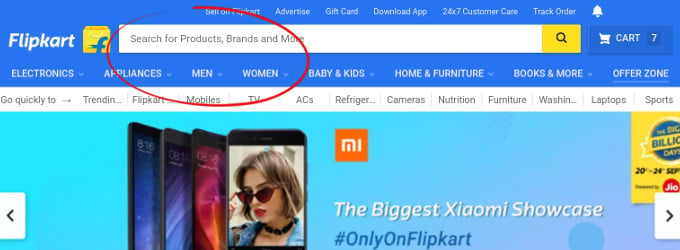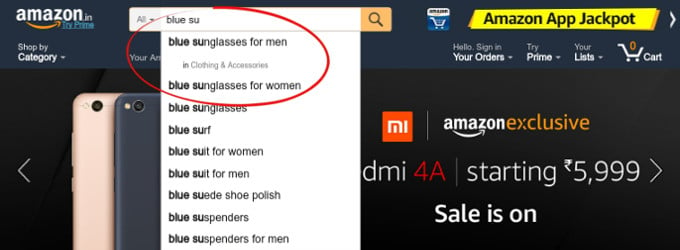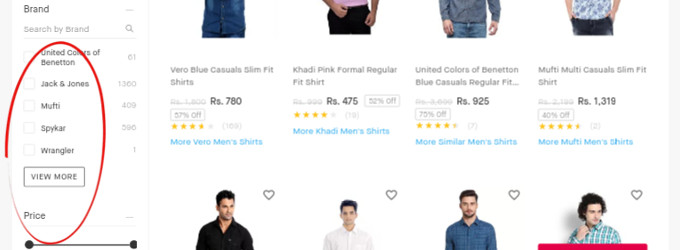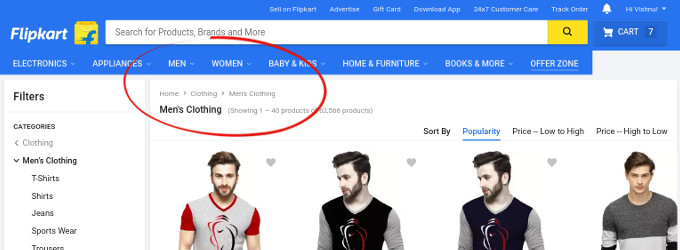Search in Ecommerce: The Vital Little Details
Setting up search in your e-commerce site is equally rewarding as getting your site promoted using multiple channels. Search can not only help your customers to easily find the item they are looking for, it can also help you to increase the conversion rates and improve your business. Refer the previous article, " How Important is Search for an Ecommerce Site? Some Facts and Figures. " for the introduction to this series.
This article explains the key areas where you should be concentrating on, to provide better user experience to your site visitors or potential customers and thus optimizing conversion rate.
Search Box - Positioning and Labelling
Obviously, to enter a search text, you need a search box. What if it is placed on a corner or on the footer? The visitor will have to “search” for the search box first and then do his actual search.
Evidence base research1 states that, the treatment for search should be straightforward :
- Make it visible
- Make it wide
- Keep it simple
Most people prefer ‘keying-in’ the search keyword than finding the products using navigation. Hence, the position for the search box should be selected such that it gains the user attention immediately. Think about the sites like Amazon and Google and see how prominent their search boxes are. Give your search box a wider space and a search button with a ‘search’ or ‘Go’ label and you will be good to go.
Drupal 8 provides you with a default search box which you can theme easily and can place it in a prominent region.
Multi Language, Dialects and Synonyms
If you have more than one language enabled in your site, then you should make sure that the user is provided with relevant search results no matter which language he or she uses to search. For instance, say you have English and Arabic enabled in your e-commerce site and a user searches contents in Arabic while accessing the English site, results should be displayed.
Similarly, product names can be different in multiple countries. A ‘biscuit’ in Britain is called a ‘cookie’ in America. So, your search should be intelligent enough to figure out this and should display the same results when these products are searched.
Another must have feature is the synonyms in search. As the name implies, user search should display results when they key in search terms that are similar to the product names added to the system. For eg: search should display results for all the words - pants, jeans or chinos.
Semantic Search
Semantic search doesn’t require a user to filter the results to get the exact product, but search understands the user intent and delivers the most accurate result. For instance, based on a user’s purchase history or search history, you can display recommended products to the user or items similar to products which the user has searched.
Semantic search is going to be the next normal search. Hence you have to add this to your portal sooner or later.
Search Suggestions
Search suggestions or autocomplete provides the user with a list of items using which they can perform search easily. Using autocomplete option can help your customers to discover products faster thereby increasing the probability of converting the visitor into a customer.
Whenever a user starts typing in, they probably expect the search box to provide suggestions - this could be because they don’t want to waste time entering the whole keyword by themselves or they don't know how to describe the exact product they are looking for or because they are used to search suggestions provided by Google.
Search suggestions can be provided based on product name, previous searched data, phrases from product descriptions etc. Suggesting ‘blue summer dress’ might not be enough to keep a visitor in your site, the suggestions should be something similar like’ blue summer dress in women's clothing’, ‘blue summer dress in kids’ etc.
On the other hand, autocomplete can also help the shop owners to show items that otherwise the customers won't search directly. An added advantage of providing autocomplete in your e-commerce portal is that, it ensures that search will return a result, as this helps the user to avoid spelling mistakes. Providing autocomplete doesn’t limit your user to search a specific category but increases conversion rate by increasing the speed of the search, faster. Both ‘Solr’ search and ‘elasticsearch’ provides options for autocomplete feature.
Filtering and Sorting
Consider a user’s frustration who has to go through 1000s of search results to find the product he wishes to buy. Hence it is indeed a good decision to provide filtering and sorting options in the search result page which allows users to select, which size they want at what price range and in what colour.
‘Out of Stock’ Products
While adding filters, it is best to provide an option for the user to choose whether or not to see the out of stock products. It is sometimes best to let the user choose what they would like to view.
Breadcrumbs
Filters applied by the user can be added as breadcrumbs in the search result page. This works as an additional navigation system in your website. Looking at the breadcrumbs will provide you the information on category and filters used to reach the product, which will help the users to know the way around. Poor navigation in an e-commerce site can be frustrating to users and they might give up what they are looking for. Hence adding these little things could really improve user experience in your site which in turn may lead to conversion.
No Results Found Page
‘No results found’ page in your e-commerce portal can tell you exactly what you could do to meet the customer expectations. By tracking this page, retailers can get an insight on what the customers are searching and what retailers are missing out. But that doesn’t mean that you can simply let the users see the ‘No results found’ page and you sit back and track.This is another opportunity where you can bring relevant content to the user.
By adding blocks like ‘Based on your recent searches’, ‘Top picks for you’, ‘More items to consider’ etc inside the ‘No results found’ page, you can attract the attention of your site users and can hopefully prevent them from leaving your site.
Search and Mobile Phones
Whatever you do in your desktop site, test thoroughly in your mobile sites as mobiles are now the next big thing. Nowadays usage of mobile phones for e-commerce purchases has increased drastically. Hence it is your responsibility to ensure that users are given a seamless experience across all devices.
Site search is definitely not something you’ll want to overlook if you want to increase your conversion rate. Once you provide few easy steps for users to have control on their search results, you might probably see conversions and increase in revenue as you help your site visitors to find what they need quickly and easily.
All of the Above and Drupal!
Be it the positioning of search box or providing relevant search suggestions to help customers in their journey, let it be configuring ‘no results page’, adding filters to your search results page, multilingual search or mobile search, Drupal has a solution for all your needs. Out-of-the-box Drupal features can be extended and be tailored to your needs. To know more, get in touch with us We will be back with next topic in the series. Keep reading.
Footnotes 1. https://www.nngroup.com/articles/113-design-guidelines-homepage-usability/







